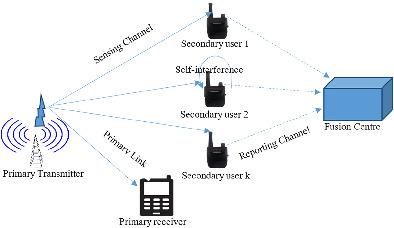当前位置:
X-MOL 学术
›
Trans. Emerg. Telecommun. Technol.
›
论文详情
Our official English website, www.x-mol.net, welcomes your
feedback! (Note: you will need to create a separate account there.)
An effective spectrum sensing in cognitive radio networks using improved convolution neural network by glow worm swarm algorithm
Transactions on Emerging Telecommunications Technologies ( IF 2.5 ) Pub Date : 2021-07-08 , DOI: 10.1002/ett.4328 Danesh K. 1 , Vasuhi S. 1
Transactions on Emerging Telecommunications Technologies ( IF 2.5 ) Pub Date : 2021-07-08 , DOI: 10.1002/ett.4328 Danesh K. 1 , Vasuhi S. 1
Affiliation

|
Spectrum sensing ranks amongst cognitive radio's most critical and demanding activities. For radio resource networks to use idle licensed bandwidth, secondary users need to identify the primary user's signal precisely. Cognitive radio networks (CRNs) have been proposed to improve the efficiency of spectrum use to meet the increasing demand for wireless bandwidth; they allow channel communication between secondary (unlicensed) and primary (licensed) users without interruption. A secondary user in a CRN must at all times track the presence of a primary user's signal to prevent the primary user (PU) from attempting to intervene whether the statistical variance of the PU data traffic would boost the prediction outcome provided by multiple current teaching algorithms in estimating the PU's average OFF time and the need for the best adaptive learning to predict accurate PU activities. The objective of the work has been modeled to identify the PUs signal. First, the data has been created via quadrature phase shift keying modulation and quadrature amplitude modulation by convolutional neural network (CNN). A dataset with different orthogonal frequency-division (OFDM) multiple access signals is generated. Then cyclo-stationary functions are extracted using the accumulation process fast Fourier Transform. This research aims to use glow worm swarm optimization (GWSO) to automatically check for the optimal design of CNNs without any manual work being required. Also, k-Nearest Neighbors (kNN) replaces Softmax, as it outperforms conventional CNN architectures with noisy signals. A comparison of the proposed classifier with another machine learning classifier, namely support vector machine, Decision tree (DT), clearly shows that SVM and DT are outperformed by the improved convolution neural network-glow worm swarm optimization (ICNN-GWSO) classification. Results of simulation show that the improved scheme outperforms conventional spectrum sensing systems, both in fading and non-fading settings, where efficiency is measured using measures such as chance, the total likelihood of error, and the ability to optimize data transfer possibilities.
中文翻译:

基于萤火虫群算法的改进卷积神经网络在认知无线电网络中的有效频谱感知
频谱感测是认知无线电最关键和要求最高的活动之一。为了使无线资源网络使用空闲的许可带宽,次用户需要准确识别主用户的信号。已经提出认知无线电网络 (CRN) 来提高频谱使用效率,以满足对无线带宽不断增长的需求;它们允许在次要(未授权)和主要(已授权)用户之间进行通道通信而不会中断。CRN 中的次要用户必须始终跟踪主要用户信号的存在,以防止主要用户 (PU) 试图干预 PU 数据流量的统计方差是否会提高多种当前教学算法提供的预测结果在估计 PU' s 平均关闭时间和最佳自适应学习的需要,以预测准确的 PU 活动。工作的目标已被建模以识别 PU 信号。首先,数据是由卷积神经网络 (CNN) 通过正交相移键控调制和正交幅度调制创建的。生成具有不同正交频分 (OFDM) 多址信号的数据集。然后使用累加过程快速傅立叶变换提取循环平稳函数。本研究旨在使用萤火虫群优化 (GWSO) 自动检查 CNN 的最佳设计,而无需任何手动工作。此外,k-最近邻 (kNN) 取代了 Softmax,因为它在噪声信号方面优于传统的 CNN 架构。将所提出的分类器与另一种机器学习分类器,即支持向量机、决策树 (DT) 进行比较,清楚地表明 SVM 和 DT 优于改进的卷积神经网络-萤火虫群优化 (ICNN-GWSO) 分类。仿真结果表明,改进的方案在衰落和非衰落环境中都优于传统的频谱感知系统,其中效率是使用诸如机会、错误的总可能性和优化数据传输可能性的能力来衡量的。
更新日期:2021-07-08
中文翻译:

基于萤火虫群算法的改进卷积神经网络在认知无线电网络中的有效频谱感知
频谱感测是认知无线电最关键和要求最高的活动之一。为了使无线资源网络使用空闲的许可带宽,次用户需要准确识别主用户的信号。已经提出认知无线电网络 (CRN) 来提高频谱使用效率,以满足对无线带宽不断增长的需求;它们允许在次要(未授权)和主要(已授权)用户之间进行通道通信而不会中断。CRN 中的次要用户必须始终跟踪主要用户信号的存在,以防止主要用户 (PU) 试图干预 PU 数据流量的统计方差是否会提高多种当前教学算法提供的预测结果在估计 PU' s 平均关闭时间和最佳自适应学习的需要,以预测准确的 PU 活动。工作的目标已被建模以识别 PU 信号。首先,数据是由卷积神经网络 (CNN) 通过正交相移键控调制和正交幅度调制创建的。生成具有不同正交频分 (OFDM) 多址信号的数据集。然后使用累加过程快速傅立叶变换提取循环平稳函数。本研究旨在使用萤火虫群优化 (GWSO) 自动检查 CNN 的最佳设计,而无需任何手动工作。此外,k-最近邻 (kNN) 取代了 Softmax,因为它在噪声信号方面优于传统的 CNN 架构。将所提出的分类器与另一种机器学习分类器,即支持向量机、决策树 (DT) 进行比较,清楚地表明 SVM 和 DT 优于改进的卷积神经网络-萤火虫群优化 (ICNN-GWSO) 分类。仿真结果表明,改进的方案在衰落和非衰落环境中都优于传统的频谱感知系统,其中效率是使用诸如机会、错误的总可能性和优化数据传输可能性的能力来衡量的。











































 京公网安备 11010802027423号
京公网安备 11010802027423号